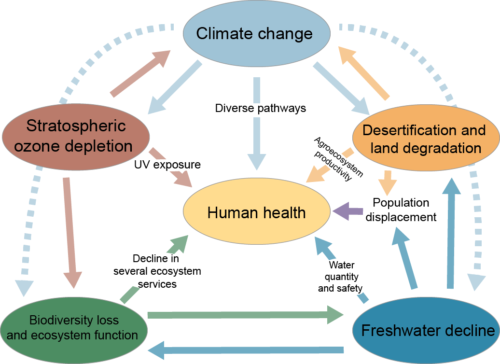Between the Devil and the Deep Blue Sea: Balancing the needs of scientific management and public stakeholders in Ecosystem Based Management
Jake Shaner, Dylan Taillie ·Scientists have long been trained to adhere to the scientific process of identifying a problem or question and testing hypotheses in an attempt to find an answer. Conventionally, this process informed management by creating a compartmentalized management scheme of the planet’s natural resources. The advent of Ecosystem Based Management (EBM) turned many of these conventional models of management around by prompting scientists and resource managers to consider the interconnectivity of our natural systems. One of the consequences of managing in this style is the elevated consideration of human elements of ecosystems, be they benefits to humans from ecosystem services, human uses of ecosystems, or the cultural importance of certain ecosystems. While EBM is constantly evolving and changing depending on which system is being managed, there are few static principles, notably integration, adaptation, precaution, and sustainability, all of which are greatly influenced by stakeholders.

One of the main tenets of Ecosystem Based Management is its inclusion of adaptive management techniques. As compared to more traditional trial and error based management, adaptive management allows for the constant monitoring and re-evaluation of methods in order to discern the effectiveness of management choices. This essentially creates large, dynamic experiments that are constantly changing to better meet management needs. This, however, presents the first instance where scientists and managers must confront the needs of public stakeholders. The public often has a much different set of expectations of resource management, expectations which are much more concerned with immediate effects of management, such as economic effects or effects on human health.
The beauty of adaptive management is that management can change to meet needs of stakeholders, or change restrictions based on review of monitoring data1. Some may even go so far as to argue that technically managers of ecosystems, being primarily government employees in the United States, have an obligation to serve the needs of the public. Generally the health of an ecosystem and the overall needs of the public at large are not mutually exclusive, but to many management can often seem burdensome or even in extreme cases tyrannical. This is where scientific communication comes into play. Adaptive management gives much greater freedom to meet a variety of needs, but scientists and managers must remain transparent in the process of management. Examples of effective scientific communication include “report cards” for natural systems, public forums, and education programs. This fosters communication among stakeholders and can often help convince the wider public of the benefit of current ecosystem management2.
In addition to adaptive management, one of a manager’s biggest tools for dealing with differing needs and opinions of the public is the use of precaution. As mentioned, public stakeholders are often concerned with immediate effects of resource management as this can directly affect their economic and cultural needs. It seems that sometimes, environmental restoration can take a lower priority than human needs. This is well illustrated by Maslow’s hierarchy, showing that will generally tend to take care of our safety and loved ones (including economically), before tending to care about more ephemeral things such as the environment.

Using the precautionary principle however can lend those who are trying to conserve and protect the environment a helping hand. A core foundation of an EBM system is the fact that the environment and human society are inextricably linked, and often, environmental concerns also become human safety concerns. The Chesapeake is a good example of this, where water quality issues can be linked to proliferation of numerous human pathogens, including Vibrio vulnificus and Mycobacteriosis3. While the precautionary principle is most easily understood and used with new technology, there can be crossover as new technologies, such as pesticides, end up affecting the environment4. The key to using the precautionary principle is the ability to balance the risk of no action with the risk of some action, while discerning how much risk is acceptable to the public.

So far we’ve seen how to consider and incorporate the public’s views in Ecosystem Based Management. What about the expectations of the public, however? When it is announced that an ecosystem or specific species is the target of a restoration, many believe these systems will be restored to some former glory. Restoration of systems can become a tricky game of semantics however, as often times an ecosystem or resource cannot be brought back to a former state because too many variables have changed. The concepts of sustainability and resilience become useful here, as managers must decide in tandem with stakeholders how to restore systems to a sustainable state, not necessarily a former state. The actual question posed to managers and researchers of systems is what functions and ecosystems services are desired in the system in question. Stakeholder input for this decision making process is imperative, as the public will benefit from certain ecosystem services. When a balance between human needs and sustainability is reached, the system, including the humans that interact with it, stand to benefit enormously.

EBM has become a promising strategy for balancing all beneficiaries and stressors while managing entire ecosystems. With the right amount of monitoring, reevaluation, stakeholder participation and communication, Ecosystem Based Management can be an effective means to manage our natural systems in an integrated and cooperative fashion.

References:
1. Rist, L., Felton, A., Samuelsson, L., Sandström, C., & Rosvall, O. (2013). A new paradigm for adaptive management. Ecology and Society, 18(4). Ecology and Society 18(4): 63.
2. Dennison W.C., Lookingbill T.R., Carruthers T.J.B., Hawkey J.M., Carter S.M. (2007) An eye-opening approach to developing and communicating integrated environmental assessments. Front. Ecol. Environ. 5(6):307–314
3. Kane, A.S., Stine, C.B., Hungerford, L., Matsche, M., Driscoll, C., & Baya, A.M. (2007). Mycobacteria as environmental portent in Chesapeake Bay fish species. Emerging infectious diseases, 13(2), 329.
4. EU efforts for Bee Health.” European Commission. Updated 2/6/2017. http://ec.europa.eu/food/animals/live_animals/bees/health_en.
Next Post > Lessons on how to synthesize science
Comments
-
Juliet Nagel 9 years ago
Well written blog! I enjoyed the addition of the satirical cartoon about protecting the beach for piping plovers. Often the public doesn't understand why or how a decision is made, they just see that the beach is inaccessible. Better communication, and involving stakeholders in decisions, is vital for environmental management.
You also mentioned sustainability and resilience of a system. Sustainability is always something to strive for, but before our class discussion, I hadn't considered that resilience can be good or bad, depending on whether the current state is desirable. For example, a field may be covered in non-native vegetation that is difficult to remove and restore to native habitat; in this case the resilience of the non-native vegetation makes the end goal more difficult to achieve. On the other hand, we would want to see resilience in a lake with a healthy balance.
-
Katie Martin 9 years ago
You mention “one of a manager’s biggest tools for dealing with differing needs and opinions of the public is the use of precaution.” It can be hard to balance the precautionary principle with all stakeholders’ interests. I like how you show that the precautionary principle can reflect the public’s interest regarding human safety concerns, but when applied to conservation can often go directly against the public’s wishes in regard to short-term needs.
-
Annie Carew 9 years ago
This is a very thorough, well-written blog. I think it does an excellent job of highlighting the importance of human needs in ecosystem management. I found the second-to-last figure particularly insightful, because it showed exactly how ecosystem degradation can affect human health. I also liked how you mentioned adaptive management and how it can be effectively used in tandem with ecosystem-based management to benefit all concerned parties.
(I also really love the Piping Plover cartoon.) -
Stephanie 9 years ago
Your post provides great insight to a pretty arcane topic; scientific motivation and public need. I think that many people have a hard time grasping the policies that they are now left to live with, and can at times feel like they aren't considered. This feeling of non consideration could be felt by either the scientist or stakeholder depending on policy, leading to further intricacy of the topic. However, this post lends to clear some confusion on either side by outlining why and how management is being enforced, and in what ways both scientific input and stakeholder needs are being considered in conception and enforcement of policies that have bo social and ecological implications.
-
Hao Wang 9 years ago
The blog is very nice and well constructed.It talked very clearly about what is the Ecosystem Based Management (EBM).It covers the core points of the precautionary principle and adaptive management.
-
Kavya Pradhan 9 years ago
I really like how this blog post pointed out that often, as demonstrated by Maslow's hierarchy, we tend to focus on the basics, take care of the security of our loved ones, and only later focus on the environment. What strikes me as odd is that the quality of the environment we live in and the fulfillment of our basic needs in inextricably linked with regard to both safety and physiological, yet we often fail to notice this linkage. I think this link is mostly highlighted when we are faced with environmental disasters that threaten our basic needs. I wonder if there is any way to highlight this link without having to face environmental degradation. In other words, are there methods to make society proactive rather than reactive. This article mentions that within the framework of EBM, we can connect environmental concern with societal concerns, but how?
-
Alterra Sanchez 9 years ago
The second to last figure, on ecosystem services, speaks volumes. The core problem of EBM, or environmental management in general, is getting the stakeholders/public to understand that it is not just the environment we are saving: we are protecting THEIR well-being and THEIR future; the future world for their children and their grandchildren. And not just a world that is livable, but a world that is comfortable, beautiful, and sustaining. If we could get the public to understand the interconnection shown by that figure, I think we would really have something that could totally change environmental policy from what it is now. Imagine if the general public were fighting with us and not against us?
-
Ana Sosa 9 years ago
I think it is very important to monitor stakeholders to ensure that their personal interests are not defining their management styles and decisions taken. The idea of "report cards" is really good, and transparency should be a priority.
-
Ginni La Rosa 9 years ago
This article successfully highlights the ongoing challenge of bridging the gap between the scientific aspects of management and the social needs of non-scientific stakeholders. However, I might suggest a slight change of wording in the sentence describing the implications of Maslow's hierarchy of needs. My guess is that the writers meant to describe the environment as an ethereal concern (i.e. abstract) rather than ephemeral (i.e. short-lived). Nevertheless, the hierarchy concept is a highly effective tool for understanding where stakeholders might stand regarding resource management decisions.
-
Hadley McIntosh 9 years ago
One thing that I find interesting about the Ecosystem Based Management approach is that it isn't being utilized as much as I would imagine. After talking with a colleague studying the social science aspects of fisheries in California. She said that ecosystem based management is good idea in concept, but there is still trouble integrating the ecosystem assessments and environmental data. I think the future of environmental based management lies in being able to pull together and make sense of all of the diverse types of data.

